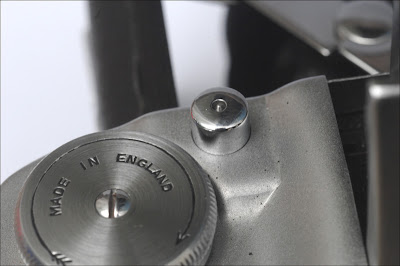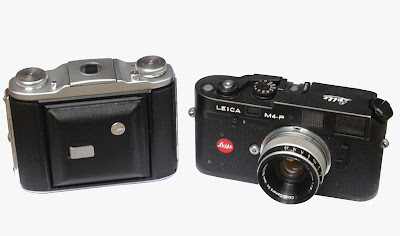
Ensign was the trademark of the British company Houghton-Butcher Ltd a company with a long history of camera and plate making. In the early part of the 20th century they were the largest British camera maker, and at its height in the 30's the Wathamstow works employed over a thousand people. After the war they found themselves with bombed out factories and in a poor financial state so joined forces with Ross the lens manufacturer and the camera factory was moved to the Ross Clapham Common works. The Selfix 1620 pictured here is a mark II model from around 1950 with a Ross Xpres F3,5 lens and has a negative size of 6x4.5. Model I cameras had an Ensar lens later ones had a built in finder rather than the alabada one the top model sported a Rosstar lens.
The camera is of excellent build quality, quite comparable to either Voigtländer or Zeiss, and has an interesting and quirky design.

First off is the shutter release which is on the left side, which in itself isn't too bad except on the right (where you'd expect the shutter release to be) is the lens board door.
Furthermore if you look at the image above of the shutter button you'll notice a central pin. The pin is designed to depress with the shutter button unless you forget to cock the shutter!- let me explain.
If you wind on the camera and forget to cock the shutter which is a lever near the aperture when you depress the button the pin pricks your finger to remind you 'please don't do that' One can only wonder in this litigious day and age how this feature could be even considered or what sort of designer would create such a feature? was he forced to sit on a spike as a child and just getting his own back?

The lens is a Ross Xpres F3,5 which I've been told is comparable to a Tessar both in design and quality. he Epsilon shutter seems to have a similar range to a Prontor. The Selfix doesn't have a rangefinder so is as manual as you can get but after a while guessing both distance and exposure aren't as problematic as it would seem.

Certainly not bad, quite up to the standard of Zeiss or Voigtländer
The image below shows the inside, special things to note are the key ways for the roll which meant that the camera can use 120 or 620 type films the bottom of the holder is sprung and when pushed down makes a plunger release from the button making for easy loading.

The following picture is just to show the size relative to my Leica, its not trying to suggest a preference for either. But it does show the relative advantage of a folding camera– medium format film in a small package, coupled with a good lens makes a very decent picture maker.

The Ensign Selfix is a great little camera if you stumble across one in a junk shop or car boot, it has its quirks (the finger pricking pin) and its main disadvantage is lack of rangefinder meaning you have to guess distance.
Also on a personal note it is the first British camera I've owned, and I remember my grandfather telling me about his Ensign 'bellows' camera.


7 comments:
The Ross Xpres is a fine lens, a Tessar design. The only problem those cameras had, were the rather unreliable epsilon shutters. Later models used a prontor shutter and they are considered to be more reliable. But your example seems to be in top condition.
Hi
Yes I've been warned about the Epsilon and that you cant change from lower to higher speeds with the shutter cocked and if you force it you can damage the shutter. I like the Ensign I think a 6x9 version would be a good find...
Quite interesting ... ! :)
Searching for a second camera in 1968 and being short of cash, I settled on a Ensign Selfix 820 (body: E21444) with a 105mm. / f3.8 Ross Xpres (lens: No.10582) from a second hand shop for £8. I had great fun with it and after using 35mm. film, I was astounded by the fact that every 3¼” x 2¼” negative I produced would enlarge well. This, of course, is because only a 3x enlargement was needed to produce a 10 x 8” print. I was surprised that a local shop was able with no hesitation to supply me with a flash adapter as it was non-standard and was bayonet-fitted into a recess. The camera was in good condition but the bellows had dried. Liberal applications of Wren’s Leather Oil were needed and they sank in like blotting paper. My Epsilon shutter, true to form, let me down but I managed to get it repaired. I was producing superb 2¼” square Ektachromes, thanks to the swing-in flaps in the film gate and how much more impressive than 35mm. transparencies they were. The Albada viewfinder was a bit of a nuisance as I always had to hold the front lens forward with my finger as I took the shot to show the view I really was going to get.
I began to wonder how people could pass up such a superb instrument. Then man landed on the Moon. I decided to copy the front page of The Daily Express, announcing the event. I pinned the newspaper to a wooden board and homed in on it. That’s when I discovered the limitations of front cell focussing….the edges of the image were mush! This was yet another folding camera that used rotation of the front lens to focus and it upset the elements. I acknowledged this limitation and learned to live with it. I had that camera for 25 years and lost it in dramatic circumstances (drugged unconscious by a Moroccan gang in Istanbul). Since then I see that the Ensign Selfix I once owned sells for silly money. One could buy a Mamiya TLR for the prices being asked. Oh well, it was a pleasant part of my photographic education and when the insurance money came through, I decided on something rather more sophisticated.
Copernicus
What a great story, thank you for sharing it with me.
I member at the local camera club has offered to sell me an Ensign Selfix 16-20 with a f4.5 Rosstar lens and Epsilon shutter, in a brown leather carry case, for £35. I've taken it home and I'm running a roll of 120 b/w film through it now. I have been shooting on a Canon DSLR for the last 6 years and wanted to go back to film. And I really like playing with the full manual settings. It means 'you' have to make the picture, not the automatic camera settings taking the shot. I will be developing the film and posting the results on my site if you want to check them out. www.peoplemakepictures.wordpress.com
thanks
Thanks for posting, film and old cameras can be great, it's really put the fun in it for me.
I will check out your blog!
happy shooting
Mark
Post a Comment